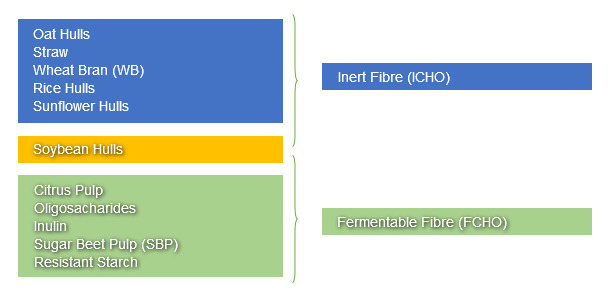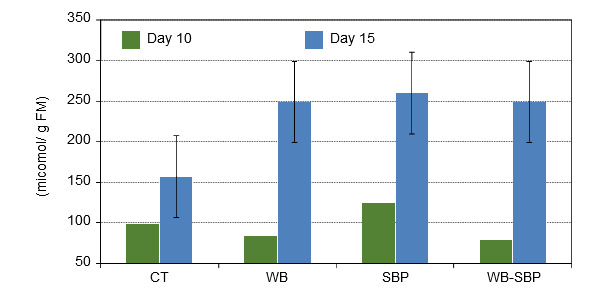Introduction
Traditionally, feeding highly digestible ingredients and including in-feed antibiotics as growth promoters has been recommended in piglets diets. However, the ban of in-feed antibiotics and the economic situation of the swine sector in EU favours the study of less complex diets in the post-weaning (PW) period. The inclusion of fibre ingredients in post-weaning diets has been controversial because fibre may reduce feed intake and nutrient digestibility, increasing the risk of proliferation of pathogenic bacteria. These controversial results can also be attributed to the lack of information regarding the functional effects of fibre ingredients such as modification of the physicochemical properties of the intestinal digesta or changes in the fermentation pattern.

Fibre sources in weaning piglet diets
Up to 90% of the cell walls of plants are made up of non-starch polysaccharides (NSP), mainly cellulose, hemicellulose and pectins. Cellulose is the structural polysaccharide present in plant cell walls and has a limited fermentable capacity in the gastrointestinal tract (GIT) of the pig. On the other hand, pectins are characterized by their high water-retention capacity, viscosity and fermentability in the hind-gut. Based on their solubility, the NSP fraction is divided into insoluble and soluble fractions. The insoluble fibre sources most commonly used in PW diets are hulls and brans from cereals and legumes. The soluble fibre sources are mainly pectins, gums, mucilage and fructans. The most common ingredients used as insoluble fibre and soluble fibre sources in post-weaning diets for pigs are exposed in Fig 1. From a functional point of view, in order to facilitate the work of the nutritionists, some feed companies have introduced 2 nutrients to control the functional characteristics of fibre: inert (ICHO) as the carbohydrates that are not digested and are not fermentable; and fermentable (FCHO) as carbohydrates that are not digested but are fermented in the large intestine.

Figure 1. Classification of feed ingredients based on the ICHO or the FCHO contribution in PW piglet diets.
Functional characteristics of fibre sources in post-weaning diets
1. Physicochemical properties
It has been shown that the inclusion of inert fibre sources in PW diets decreased digesta retention time and modified the gut ecosystem resulting in a reduction of the proliferation of pathogens in the small intestine (Kim et al., 2012; Heo et al., 2013). Gerritsen et al. (2012) reported that the addition of 50 g wheat straw and 100 g oat hulls/kg (in total 128 g ICHO/kg and 96 g FCHO/kg) to a cereal-based diet during the first 14 d PW increased feed intake of the pigs, as compared with a cereal-based diet or a positive control diet rich in milk by-products and crystalline amino acids (Table 1). In the same experiment, an increase in the stomach weight and in the amylase activity in the intestinal brush border together with lower E. coli counts in the ileum and colon digesta were also associated with the ICHO diet. The physiological effects of including ICHO fibre sources in PW pig diets seem to be related to a higher feed intake and better development of the GIT. Also, ICHO might reduce E. coli counts in the small intestine because of a direct physical effect of these ingredients by blocking the E. coli adhesion to the small intestine receptors of the pigs.
The inclusion of FCHO sources in diets during the early post-weaning period has been associated with a reduction in organ development and increasing in intestinal viscosity. An increase in intestinal viscosity might reduce the digestion and absorption of nutrients in the diet resulting in PW diarrhoea. Therefore, ingredients that increase digesta viscosity may be detrimental to pig health and production.
Table 1. Effect of the diet on pig performance from 28 to 42 days of age. Adapted from Gerritsen et al. (2012).
| Diets a | SEM | P-value | |||
| PC | NC | iNSP | |||
| ADFI (g/day) | 280.8 y | 284.1 y | 328.1 x | 6.82 | 0.001 |
| ADG (g/day) | 209.2 | 229.8 | 240.0 | 5.43 | 0.102 |
| G:F | 0.75 x | 0.81 y | 0.73 x | 0.02 | 0.001 |
| Amylase activity in the jejunum mucosa (mmol/g protein) |
0.030 | 0.028 | 0.032 | 0.001 | 0.060 |
| Stomach weight (% body weight) | 0.78 y | 0.76 y | 0.89 x | 0.04 | 0.103 |
| E. coli ileum b | 5.6 x | 4.8 xy | 3.8 y | 0.01 | 0.021 |
| E. coli colon c | 6.8 x | 5.6 x | 3.9 y | 0.42 | 0.002 |
Different superscripts (x, y) in the same row denote a significant difference (P≤0.05).
a Diets: PC (positive control), NC (negative control), iNSP (insoluble non-starch polysaccharides diet with 50 g wheat straw and 100 g oat hulls/kg). (10 replicate pens of 6 pigs each).
b Escherichia coli counts in the ileum digesta (Log10/g).
c Escherichia coli counts in the colon digesta (Log10/g).
2. Fermentability

The fermentation of dietary fibre compounds by the GIT microbiota results in the generation of short chain volatile fatty acids (SCFA). The inclusion of ICHO in piglet diets increases water-retention of the digesta and provides substrates that will be fermented slowly in the distal part of the GIT. Consequently, the composition of the GIT microbiota will depend on the fermentation capacity of the weaned pigs. Molist et al. (2009) observed a sharp increase in the concentration of SCFA in the caecum of pigs fed diets containing 40 to 80 g wheat bran or 30 to 60 g sugar beet pulp/kg of diet as compared with pigs fed a control diet on 10 to 15 d PW without any supplemented fibre (Fig. 2). Therefore, the inclusion of FCHO in the diet of post-weaning pigs has been related to a higher incidence of PW diarrhoea in the first 2 weeks post-weaning, because pigs of this age have limited capacity to ferment fibre which results in the accumulation of non-fermentable material in the GIT. Montagne et al. (2012) studied the interaction between fibre content of the diet and sanitary conditions of the farm on the growth and health status of weaned pigs. In this research, piglets fed a combination of 60 g sugar beet pulp and 20 g soybean hulls/kg diet and allocated in rooms with a high infection pressure showed a lower feed intake for the first 2 weeks PW and a higher incidence of PW diarrhoea than pigs from the other experimental groups. The authors concluded that the inclusion of ingredients containing highly fermentable fibre immediately after weaning represent an additional risk factor for pig health and growth, especially under poor sanitary conditions.

Fig. 2. Concentration of short-chain fatty acid on colon digesta of piglets 10 and 15 days after weaning fed 4 different experimental dietsa. (Adapted from Molist et al. 2009).
a Diets: CT (control diet); WB (CT+ 80 g wheat bran/kg); SBP (CT+ 60 g sugar beet pulp/kg); and WB–SBP (CT+ 40 g wheat bran/kg and 30 sugar beet pulp/ kg). (8 replicate per treatment).
Conclusions
Predicting the functional effect of fibre ingredients when fed to early weaning piglets is advisable in order to control the gut health. Optimizing the PW diets by the utilization of inert (ICHO) and fermentable (FCHO) instead of crude fibre can be a solution. The moderate inclusion (65-130 g ICHO/kg) of ICHO in the PW diet will help piglets to develop the GIT and improve the gut health and growth performance.
On the other hand, the inclusion of FCHO in the diet for the first two weeks after weaning, especially with early weaning in farms with a poor health status, might be contraindicative due to the limited digestive capacity of the piglets. Once the pigs adapt to solid feed, higher amounts of FCHO can be gradually included in the diet to promote a healthy fermentation pattern and growth of the piglets.



